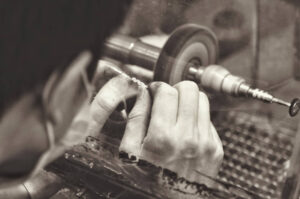
Actually, it all started back in 2011. At the time, the curators of a few natural history and hunting museums in several European cities were surprised to find that the horns had been stolen from their historical rhino skulls. Many newspapers found this rather amusing. 19th century hunting trophies were considered rather embarrassing cultural assets, and people of good taste no longer found them worthy of being exhibited anyway. The fact that men with an inferiority complex had driven up the value of an old rhinoceros horn to up to 60,000 euros caused slight disconcertment.
The museums that had been robbed – mainly small institutions with rather limited security mechanisms – warned other museums, and they reacted by putting all exhibits with rhino horns into their depository for the time being. They are still there. Zoos stepped up their security measures too since a rhino was shot and robbed of its horn in the private Thoiry Zoo in the French town of Thoiry-en-Yvelines.

Collectables Do Not Only Have a Collectors’ Value, They Also Have a Material Value
What do these bizarre reports have to do with the thefts at the Berlin Bode Museum and the Dresden Zwinger? Well, it’s quite simple: the rhino horn thefts of 2011 were the first manifestations of a fact that had almost fallen into oblivion: collectables are not only of value to collectors, they also have a material value. Unscrupulous criminals can avoid the risk of selling their illegal goods to a fence by reducing stolen items to their material and inserting them into the commodity cycle without being caught. Laymen cannot tell whether a rhino horn has just been poached in Africa or whether it was stolen from a European museum, just like the average consumer cannot tell the difference between melted-down dental gold and gold from a melted-down Big Maple Leaf, or between a newly cut diamond from an African mine or a diamond taken from an ancient decoration.
Jewellers as Distributors of the Big Maple Leaf
The Big Maple Leaf wasn’t made of “normal” gold but of gold with a particularly high fineness. That’s why the police are still hoping to find traces of the coin. For this purpose, 120 detectives and a hundred-strong unit of riot police officers conducted house searches in private apartments and premises of Berlin jewellers in the Berlin districts of Neukölln and Reinickendorf on 16 December 2020 at 7 a.m. They were looking for traces of the Maple Leaf gold.
Even though none of the eight suspects, which are between 14(!) and 51 years old, were arrested they seized evidence: presumably counterfeit bullion coins, counterfeit equipment and cash.
This supports the theory put forward by numerous media outlets: the Big Maple Leaf was melted down a long time ago. The gold was probably used to produce an abundance of small (fake) bullion coins. This approach is in line with the current situation of the market. Currently, gold bullion products are among the items in short supply in Germany. Numerous frightened investors consider gold to be a secure investment. Therefore, Berliners who bought their bullion coins in a jewellery shop in Neukölln or Reinickendorf might have a piece of the Big Maple Leaf at home – and that, in turn, means those pieces are collectibles, however, this will only be true a couple of decades from now when the coins can no longer be confiscated as evidence.

About the Fate of the Historical Jewels from the Dresden Zwinger
From knowing this, it’s not far to the very probable hypothesis that we can no longer expect to see the orders and valuable of Augustus the Strong ever again. The breast ribbon alone was made of 51 large and 611 small diamonds, the magnificent rapier of the Diamond Rose Garniture had nine large and 770 small diamonds, and the breast star of the Order of the White Eagle displayed 200 diamonds. Individual pieces are up to 49 carats. If you keep in mind that a diamond weighing one carat has already a price of 4,000 to 6,000 euros, you can truly understand the financial potential of the theft. The stolen exhibits simply aren’t priceless, their material value can actually be quantified quite precisely.
Thanks to the excellent connections of the Remmo Clan, having the diamonds recut was probably a piece of cake. After all, the art of diamond cutting is not only carried out in Antwerp. And jewellery shops sell both bullion coins and all forms of diamond jewellery.
In any case, the investigators no longer expect to find the historical pieces. The state chairman of the Federation of German Police Officers (BDK), Peter Guld, said: “I’m afraid that merely the material value was of any importance to the perpetrators and that only individual parts of the objects will reappear, if at all.”
What Does That Mean for the Protection of Cultural Property?
While many had considered rhino horns and the Big Maple Leaf to be rather inferior cultural assets and grinned about the thought that these objects were sold as raw material, the loss of the historically important jewels from the Dresden Zwinger is painful for all of us.
However, only a few people might be aware of the fact that we went around in a circle regarding the destruction of historical heritage for the sake of its material value. We are back where we were in the 19th century, when mummy parts were sold as exotic medicine, gold coins stolen from the Bibliothèque nationale were melted down and the reliefs of the Pergamon Altar, which Humann couldn’t bring to Berlin due to time constraints, were burned in a lime kiln.
Cultural assets will only be cultural assets and valuable if someone attaches cultural value to them. Don’t forget, besides collectors and culturally interested people, there is also a large group of people in Europe who don’t care (anymore) about cultural heritage. It doesn’t come as a surprise that the majority of criminals belongs to the latter.

The End of Early Warning Systems?
This could also have an impact on the early warning system of the IAPN and the national dealer associations who are taking part. While the chances of getting stolen coins back were quite high a few decades ago because attentive dealers noticed whenever coins offered to them were on early warning lists, in times of the internet and emails the probability of recovering the loot hasn’t increased but fallen. Today, it’s simply too easy to search the internet for certain objects by means of an image search. There are hardly any items left – except in museums – that haven’t been photographed at some point. After all, the major part of coin sales today takes place in online auctions and web shops. Therefore it is practically impossible to sell a stolen collection.
However, that doesn’t mean that coins will no longer be stolen, as it started to begin with paintings. Quite the opposite: precious metal can be melted down. Thus, stolen coins won’t be sold in the form of objects but will be melted down. Small melting furnaces can be purchased online for less than 200 euros.
And that means that anyone who holds a collection dear to their heart shouldn’t store it in a drawer at home, but in a maximum-security vault.
For museums, which are supposed to protect our cultural heritage, this means that every curator should carefully consider if there’s a reasonable balance between the material value of the exhibits and the museum’s security measures before displaying any item. Therefore, documenting your own collection becomes all the more important, not only for the purpose of proving which pieces were stolen in the event of theft, but also to preserve the message of every item for posterity as it might be melted down.
Considering that all our nations once again have to cut back on culture and the police due to the high expenses that had to be made in 2020, it becomes apparent that coins in our museums will be a preferred target of robbers who want to combine high profits and a low risk.
You can read about poachers breaking into a zoo to steal rhino horns in The Independent.
We covered the theft of the Big Maple Leaf from the Bode Museum on several occasions, our last article dealt with the verdicts.
We also reported on the Dresden raid in November.
CBC reported on later raids in Berlin jewellery shops.




